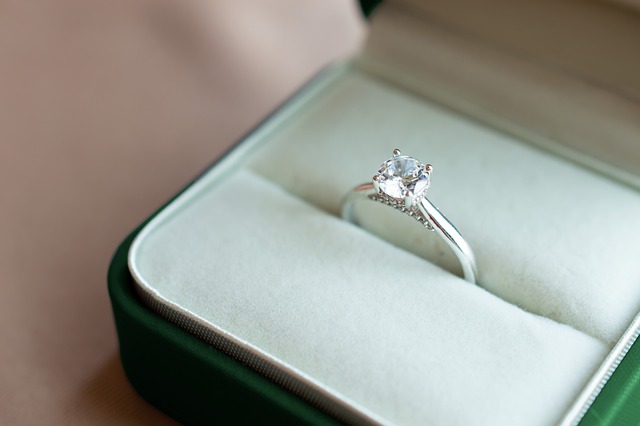You must make an intelligent choice if you plan to buy a ring for your wife. One of the choices you can make is to choose a moissanite over a diamond. This is a more cost-effective option, it is more sustainable, and it is more ethical.
It’s shinier and more refractive of light than a diamond
Moissanite is a type of gemstone similar to diamonds in color and appearance, but it is more durable, iridescent, and refractive. These are some reasons it is becoming more popular in jewelry.
Moissanite is a mineral form of silicon carbide, a chemical compound of silicon and carbon. Silicon carbide is a tricky substance, ranked second only to diamonds. It is also resistant to cracking and damage.
Moissanite is a natural mineral, which means that it is formed naturally. Until the 1990s, it was used for industrial applications. Today, most Moissanite are lab-grown. They are physically identical to earth-grown stones but can be produced at a fraction of the cost.
Lab-grown gems are growing in popularity because they can be sold at a fraction of the cost of a real diamond. But, there are some ethical concerns with this option.
Some people find that the sparkle of lab-grown Moissanite is not natural. This is because the facets of Moissanite are cut differently than a diamond.
The result is that Moissanite has a “disco-ball” effect. Instead of bending light, it reflects it in a colorful flash. As a result, Moissanite is much more visible in daylight.
The brilliance of a moissanite is far superior to that of a diamond. Diamonds usually have a yellow or brown tinge, whereas Moissanite is a near-colorless stone.
It produces stronger flashes of light than a diamond
Moissanite is an alternative to diamonds, often touted as a low-cost option. Although it is not exactly the same as a diamond, the two gems have similar chemical properties.
The brilliance of Moissanite is impressive. Its rainbow flashes of light are usually more noticeable in larger stones.
While a diamond produces the same sparkle, its colors are more numerous. Diamonds are also known for their durability.
However, diamonds have visible flaws. Moissanite has a higher refractive index than diamonds, producing more sparkle.
Moissanite is also known to have an interesting “disco-ball” effect when exposed to sunlight. This can be especially attractive to some, and some prefer the product.
Generally, Moissanite is considered to be an artificial diamond. It is made in a lab rather than naturally.
While some diamonds have a nice disco-ball effect, it isn’t quite as spectacular as the one that Moissanite produces. Some people find the sparkle of Moissanite to be more artificial than the one that diamonds produce.
However, some people may appreciate the technology used to create Moissanite. A diamond’s complex three-dimensional effect causes it to bend and reflect light. These flashes of light are called scintillation.
Lastly, diamonds are a highly unethical product. They are a popular choice for engagement rings.
It’s cheaper than a diamond
Moissanite and diamonds may look similar, but they have very different features. Diamonds are mined, while Moissanite is created in a lab. This is why Moissanite is much cheaper than diamonds.
In addition to the lower price tag, a Moissanite is less valuable than a diamond. For example, a half-carat diamond costs twice as much as a 6.5mm moissanite stone.
Besides cost, another difference between the two is brilliance. While both are brilliant, a diamond has a single-hue brilliance, while a moissanite has rainbow light flashes.
Another feature of a diamond is its “fire.” Moissanite has a multi-colored fire. The larger the moissanite stone, the more fire it produces. However, the fire is less noticeable in small stones.
Aside from being cheaper, Moissanite is also a socially responsible gemstone. Diamonds have been mined in Africa, Russia, and Canada. Some of these countries have better mining conditions than others. These miners are paid very little and live a tough life.
One of the most amazing things about diamonds is their formation. Scientists have been able to simulate the conditions that formed the diamonds millions of years ago. Now, they can create lab-grown diamonds that look and feel precisely like earth-grown diamonds. They can be more affordable than natural diamonds and be passed down for generations.
It’s more sustainable and ethical
Moissanite is an eco-friendly and ethical alternative to diamonds. It is grown in the lab and has a much lower carbon footprint than mined gemstones.
In addition to having a smaller carbon footprint, it is also a lot cheaper. For example, one ring made of Moissanite can be 90% cheaper than the same size ring with diamonds. That means it can be allocated to the wedding budget or even as a down payment for a house.
Another benefit of Moissanite is that it does not require large-scale mining operations. This avoids the risk of deforestation. Additionally, it isn’t exposed to foreign materials that can harm the environment.
Also, because it’s grown in a lab, the workers are paid fairly and treated respectfully. The lab environment is not affected by the production.
If you’re wondering how it’s different from diamonds, it’s because it’s not a natural mineral. It’s silicon carbide. Silicon carbide is a chemical substance other than diamonds’ pure carbon composition.
Diamonds, on the other hand, are naturally occurring. They are very hard and incredibly durable. However, they’re also expensive. Many couples today opt for more sustainable options when choosing an engagement or wedding ring.
Consider a moissanite if you’re still considering an engagement ring or wedding ring. These jewels are produced in a lab and are less expensive than a mined gemstone.
Featured Image by Priscila Flores from Pixabay
